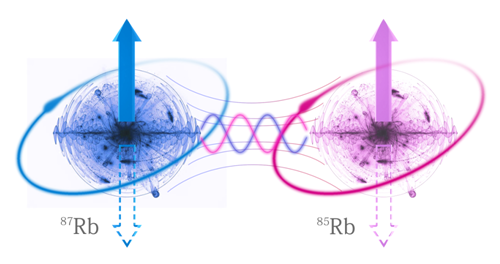|
|
Physicists Realized Entangling Two Distinct Atoms for First Time |
| Author: |
|
Update time: |
2017-11-01 |
|
Two neutral atoms of different isotopes have been entangled by Prof. ZHAN Mingsheng’s group for the first time in Wuhan Institute of Physics and Mathematics.
Inter-species entanglement of non-identical particles is predicted to exist in various compound quantum systems, ranging from hydrogen atoms, to Bose-Bose mixtures, and even in photosynthetic light-harvesting complexes. Controlling this type of entanglement is crucial for simulating and understanding of exotic physics of related systems, especially for strongly correlated many–body systems, such as high–temperature superconductors, fractional quantum Hall states, or quantum phase transitions. Trapped ultracold neutral atomssystem is considered as a natural platform for simulating many–body systems. However, the inter-species entanglement between atoms has not been obtained due to the very weak interactions.
In Prof. ZHAN’s group, ZENG Yong and his colleagues firstly confined an87Rbatom and an85Rb in two single–atom optical traps, then coherently excited single atom to a highly excited Rydberg state using two photon transitions.They made full use of the frequency difference of 85Rb and 87Rb transitions toachieve the addressing and manipulating of the single atoms even with 3.8 μmqubit spacing.
Compared with the single atoms of same species, their work has lower crosstalk, stronger dipole-dipole interactions between Rydberg states and more efficient Rydberg blockade. Finally, they realized the quantum control-NOT gate and quantum entanglement between two heteronuclear atoms for the first time.
This work, together with the technologies developed in identical atoms, can in principle simulate most of the many–body systems with multi-species interactions.It will trigger the quest for new protocols and scheme to use the double species in quantum simulation and quantum computation.
Resultsentitled“Entangling Two Individual Atoms of Different Isotopes via Rydberg Blockade”were published in Physical Review Letters. Itwas supported by the National Key Researchand Development Program of China, the Strategic Priority ResearchProgram of the Chinese Academy of Sciences, the National Natural ScienceFoundation of China under Grants and Youth Innovation Promotion Association. 
Artist's conception of the quantum entanglement of two distinct atoms(Image by ZHAN’s group) ContactZHAN Mingsheng,mszhan@wipm.ac.cn
Key words: atoms, isotopes,quantum entanglement, cross talk |
|
|